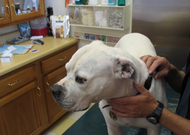Hope for Treatment-Resistant Epilepsy: Crystal’s Story
Aug 20th 2025
When I first met Crystal, a striking white American bulldog, she had a quiet grace and sweetness that immediately drew me in. But her story was unfortunately anything but calm. Crystal had been suffering from terrifying, treatment-resistant seizures since she was just two years old.
Her pet parent, Cheryl, described the helplessness she felt watching Crystal collapse into full-body tremors, unresponsive, sometimes in clusters of three or four seizures in a single episode. These episodes left Crystal physically depleted and emotionally shaken, for both of them.
Initially, their vet prescribed phenobarbital and potassium bromide, but while the seizures continued, Crystal’s spirit dimmed. Cheryl described her as a “walking zombie,” stumbling around and barely present. A neurologist added a third drug, gabapentin, which dulled her less, but the seizures persisted. Extensive tests, including an MRI, came back normal. No tumor. No structural abnormalities. Just a mystery and a very difficult one to treat.
That’s when Cheryl found me, and we began a new path.
At my integrative clinic in Boulder, I see many pets like Crystal: those who haven’t responded to traditional therapies alone. Rather than replacing medications, I layer natural therapies alongside them. We started with acupuncture, a ketogenic diet, and nutraceuticals like taurine, high-dose omega-3s, B vitamins, and vitamin D. We also added liver support with milk thistle extract due to the strain of long-term anticonvulsants.
Cheryl was remarkably committed, making the hour-long drive each week for acupuncture and reassessments. Slowly, we saw some improvement with fewer seizures, and shorter ones when they did occur.
Inspired by research on children with Dravet syndrome, I introduced CBD into her protocol. At first, we saw no change at low doses, so I carefully increased the amount, incorporating a product I’d formulated: The Silver Bullet, a blend of CBD and CBG. These cannabinoids, especially when combined, showed promise in studies for reducing seizure frequency in dogs.
Over several months, as we increased the dosage and kept all other therapies consistent, Crystal’s seizures became less frequent and far less severe. Eventually, we were able to taper off phenobarbital and potassium bromide completely. She remained on a reduced dose of gabapentin and continued her acupuncture, herbs, and cannabinoid therapy.
We reached a point where Crystal went two full months without a seizure, which was a major milestone.
Managing refractory epilepsy is complex. It requires time, patience, a thoughtful approach, and a willingness to blend therapies for the sake of the animal’s quality of life. Crystal’s journey hasn’t been easy, but it’s a testament to what’s possible when we refuse to give up hope and when we explore every tool available to help our animals thrive.
If you have a pet like Crystal, know this: there are options. And there is hope.
